Land Use Dynamics and Impact on Regional Climate Post-Tehri Dam in the Bhilangana Basin, Garhwal Himalaya
Abstract
1. Introduction
2. Study Area
3. Materials and Methods
3.1. Processing of Satellite Images
3.1.1. Conversion to TOA Radiance
3.1.2. Conversion to TOA Reflectance
3.2. Land Use/Cover Change Detection
3.3. Validation of Land Use
3.4. NDVI Analysis
3.5. Climatic Variability
4. Results
4.1. Land Use Dynamics
4.2. Climatic Variability
5. Discussion
6. Conclusions
Supplementary Materials
Author Contributions
Funding
Institutional Review Board Statement
Informed Consent Statement
Data Availability Statement
Acknowledgments
Conflicts of Interest
References
- Lambin, E.F.; Geist, H.J.; Lepers, E. Dynamics of land-use and land-cover change in tropical regions. Annu. Rev. Environ. Resour. 2003, 28, 205–241. [Google Scholar] [CrossRef]
- Habel, M.; Mechkin, K.; Podgorska, K.; Saunes, M.; Babiński, Z.; Chalov, S.; Absalon, D.; Podgórski, Z.; Obolewski, K. Dam and reservoir removal projects: A mix of social-ecological trends and cost-cutting attitudes. Sci. Rep. 2020, 10, 19210. [Google Scholar] [CrossRef]
- Bonan, G.B. Forests and Climate Change: Forcings, Feedbacks, and the Climate Benefits of Forests. Science 2008, 320, 1444–1449. [Google Scholar] [CrossRef] [PubMed]
- Tuan, N.T. Urbanization and land use change: A study in Vietnam. Environ. Socio Econ. Stud. 2022, 10, 19–29. [Google Scholar] [CrossRef]
- Sobala, M. Landscape effects of conflicts in space management. A historical approach based on the Silesian and Zywiec Beskids (West Carpathians, Poland). Environ. Socio Econ. Stud. 2016, 4, 51–60. [Google Scholar] [CrossRef][Green Version]
- Bajracharya, B.; Uddin, K.; Chettri, N.; Shrestha, B.; Siddiqui, S.A. Understanding land cover change using a harmonized classification system in the Himalaya. Mt. Res. Dev. 2010, 30, 143–156. [Google Scholar] [CrossRef]
- Batar, A.K.; Watanabe, T.; Kumar, A. Assessment of land-use/land-cover change and forest fragmentation in the Garhwal Himalayan region of India. Environments 2017, 4, 34. [Google Scholar] [CrossRef]
- Kala, R.; Bhavsar, D.; Roy, A.; Rawat, L. Land use/land cover dynamics study and prediction in Garhwal region of Western Himalaya. In Proceedings of the 38th Asian Conference Remote Sensing Space Applications: Touching Human Lives ACRS, New Delhi, India, 23–27 October 2017. [Google Scholar]
- Kuniyal, J.C.; Jamwal, A.; Kanwar, N.; Chand, B.; Kumar, K.; Dhyani, P.P. Vulnerability assessment of the Satluj catchment for sustainable development of hydroelectric projects in the northwestern Himalaya. J. Mt. Sci. 2019, 16, 2714–2738. [Google Scholar] [CrossRef]
- Mondal, P.P.; Zhang, Y. Research Progress on changes in land use and land cover in the Western Himalayas (India) and effects on ecosystem services. Sustainability 2018, 10, 4504. [Google Scholar] [CrossRef]
- Asher, M.; Bhandari, P. Mitigation or Myth? Impacts of Hydropower Development and Compensatory Afforestation on forest ecosystems in the high Himalayas. Land Use Policy 2021, 100, 105041. [Google Scholar] [CrossRef]
- Fearnside, P.M. Reservoir (Brazil’ S Tucuruí Dam) and the Energy Policy Implications. Water Air Soil Pollut. 2002, 133, 69–96. [Google Scholar] [CrossRef]
- Sati, S.P.; Sharma, S.; Sundriyal, Y.P.; Rawat, D.; Riyal, M. Geo-environmental consequences of obstructing the Bhagirathi River, Uttarakhand Himalaya, India. Geomat. Nat. Hazards Risk 2020, 11, 887–905. [Google Scholar] [CrossRef]
- Singh, M.S.; Upreti, P. Reservoir induced impact on Agricultural patterns and Livelihood practices: A case study of Pratapnagar block in Tehri dam rim area. Int. J. Sci. Res. Publ. 2015, 5, 1–8. [Google Scholar]
- Velastegui-Montoya, A.; de Lima, A.; Herrera-Matamoros, V. What Is the Socioeconomic Impact of the Tucuruí Dam on Its Surrounding Municipalities? Sustainability 2022, 14, 1630. [Google Scholar] [CrossRef]
- Velastegui-Montoya, A.; de Lima, A.; Adami, M. Multitemporal Analysis of Deforestation in Response to the Construction of the Tucuruí Dam. ISPRS Int. J. Geo Inf. 2020, 9, 583. [Google Scholar] [CrossRef]
- Llerena-Montoya, S.; Velastegui-Montoya, A.; Zhirzhan-Azanza, B.; Herrera-Matamoros, V.; Adami, M.; de Lima, A.; Moscoso-Silva, F.; Encalada, L. Multitemporal Analysis of Land Use and Land Cover within an Oil Block in the Ecuadorian Amazon. ISPRS Int. J. Geo Inf. 2021, 10, 191. [Google Scholar] [CrossRef]
- Xu, X.; Xie, Y.; Qi, K.; Luo, Z.; Wang, X. Detecting the response of bird communities and biodiversity to habitat loss and fragmentation due to urbanization. Sci. Total Environ. 2018, 624, 1561–1576. [Google Scholar] [CrossRef]
- Hietala-Koivu, R.; Lankoski, J.; Tarmi, S. Loss of biodiversity and its social cost in an agricultural landscape. Agric. Ecosyst. Environ. 2004, 103, 75–83. [Google Scholar] [CrossRef]
- Macedo, M.N.; DeFries, R.S.; Morton, D.C.; Stickler, C.M.; Galford, G.L.; Shimabukuro, Y.E. Decoupling of deforestation and soy production in the southern Amazon during the late 2000s. Proc. Natl. Acad. Sci. USA 2012, 109, 1341–1346. [Google Scholar] [CrossRef]
- Rautela, P.; Mitigation, D.; Centre, M. GIS and remote sensing-based study of the reservoir-induced land-use/land- cover changes in the catchment of Tehri dam in Garhwal Himalaya, GIS and remote sensing-based study of the reservoir-induced land-use/land-cover changes in the catchment of Te. Curr. Sci. 2017, 83, 308–311. [Google Scholar]
- Rathore, P.; Roy, A.; Karnatak, H. Predicting the future of species assemblages under climate and land use land cover changes in Himalaya: A geospatial modelling approach. Clim. Chang. Ecol. 2022, 3, 100048. [Google Scholar] [CrossRef]
- Rasool, R.; Fayaz, A.; ul Shafiq, M.; Singh, H.; Ahmed, P. Land use land cover change in Kashmir Himalaya: Linking remote sensing with an indicator based DPSIR approach. Ecol. Indic. 2021, 125, 107447. [Google Scholar] [CrossRef]
- Das, P. 20 years MODIS-NDVI monitoring suggests that vegetation has increased significantly around Tehri Dam reservoir, Uttarakhand, India. Remote Sens. Appl. Soc. Environ. 2021, 24, 100610. [Google Scholar] [CrossRef]
- Chughtai, A.H.; Abbasi, H.; Karas, I.R. A review on change detection method and accuracy assessment for land use land cover. Remote Sens. Appl. Soc. Environ. 2021, 22, 100482. [Google Scholar] [CrossRef]
- Dorji, T.; Odeh, I.O.A.; Field, D.J.; Baillie, I.C. Digital soil mapping of soil organic carbon stocks under different land use and land cover types in montane ecosystems, Eastern Himalayas. For. Ecol. Manag. 2014, 318, 91–102. [Google Scholar] [CrossRef]
- Hassan, Z.; Shabbir, R.; Ahmad, S.S.; Malik, A.H.; Aziz, N.; Butt, A.; Erum, S. Dynamics of land use and land cover change (LULCC) using geospatial techniques: A case study of Islamabad Pakistan. SpringerPlus 2016, 5, 1–11. [Google Scholar] [CrossRef]
- Tiwari, P. Land use changes in Himalaya and their impacts on environment, society and economy: A study of the Lake Region in Kumaon Himalaya, India. Adv. Atmos. Sci. 2008, 25, 1029–1042. [Google Scholar] [CrossRef]
- Camacho, C.; Pérez-Barahona, A. Land use dynamics and the environment. J. Econ. Dyn. Control 2015, 52, 96–118. [Google Scholar] [CrossRef]
- Ullah, S.; Ahmad, K.; Sajjad, R.U.; Abbasi, A.M.; Nazeer, A.; Tahir, A.A. Analysis and simulation of land cover changes and their impacts on land surface temperature in a lower Himalayan region. J. Environ. Manag. 2019, 245, 348–357. [Google Scholar] [CrossRef]
- Hussain, S.; Lu, L.; Mubeen, M.; Nasim, W.; Karuppannan, S.; Fahad, S.; Tariq, A.; Mousa, B.G.; Mumtaz, F.; Aslam, M. Spatiotemporal Variation in Land Use Land Cover in the Response to Local Climate Change Using Multispectral Remote Sensing Data. Land 2022, 11, 595. [Google Scholar] [CrossRef]
- Rohini, P.; Rajeevan, M.; Srivastava, A.K. On the Variability and Increasing Trends of Heat Waves over India. Sci. Rep. 2016, 6, 1–9. [Google Scholar] [CrossRef]
- Mishra, V.; Mukherjee, S.; Kumar, R.; Stone, D.A. Heat wave exposure in India in current, 1.5 °C, and 2.0 °C worlds. Environ. Res. Lett. 2017, 12, 124012. [Google Scholar] [CrossRef]
- Lal, P.; Shekhar, A.; Kumar, A. Quantifying Temperature and Precipitation Change Caused by Land Cover Change: A Case Study of India Using the WRF Model. Front. Environ. Sci. 2021, 9, 766328. [Google Scholar] [CrossRef]
- IPCC. Climate Change 2022–Impacts, Adaptation and Vulnerability; IPCC: Geneva, Switzerland, 2022; Volume 37, Available online: https://www.ipcc.ch/report/ar6/wg2/ (accessed on 15 May 2022).
- Hussain, S.; Mubeen, M.; Ahmad, A.; Majeed, H.; Qaisrani, S.A.; Hammad, H.M.; Amjad, M.; Ahmad, I.; Fahad, S.; Ahmad, N.; et al. Assessment of land use/land cover changes and its effect on land surface temperature using remote sensing techniques in Southern Punjab, Pakistan. Environ. Sci. Pollut. Res. 2022, 1–17. [Google Scholar] [CrossRef]
- Hussain, S.; Karuppannan, S. Land use/land cover changes and their impact on land surface temperature using remote sensing technique in district Khanewal, Punjab Pakistan. Geol. Ecol. Landsc. 2021, 1–13. [Google Scholar] [CrossRef]
- ul Hassan, W.; Nayak, M.A.; Lyngwa, R.V. Recent changes in heatwaves and maximum temperatures over a complex terrain in the Himalayas. Sci. Total Environ. 2021, 794, 148706. [Google Scholar] [CrossRef] [PubMed]
- Chapman, S.C.; Watkins, N.W.; Stainforth, D.A. Warming Trends in Summer Heatwaves. Geophys. Res. Lett. 2019, 46, 1634–1640. [Google Scholar] [CrossRef]
- Ahmad, S.; Jia, H.; Chen, Z.; Li, Q.; Yin, D.; Israr, M.; Hayat, W.; Bilal, H.; Ahmed, R.; Ashraf, A. Effects of climate and land use changes on stream flow of Chitral river basin of northern highland Hindu-Kush region of Pakistan. J. Hydro Environ. Res. 2021, 38, 53–62. [Google Scholar] [CrossRef]
- Port, U.; Claussen, M.; Brovkin, V. Radiative forcing and feedback by forests in warm climates—A sensitivity study. Earth Syst. Dyn. 2016, 7, 535–547. [Google Scholar] [CrossRef]
- Pal, S.C.; Chowdhuri, I.; Das, B.; Chakrabortty, R.; Roy, P.; Saha, A.; Shit, M. Threats of climate change and land use patterns enhance the susceptibility of future floods in India. J. Environ. Manage. 2022, 305, 114317. [Google Scholar] [CrossRef]
- Pandey, V.K.; Tripathi, A.K.; Sharma, K.K. Implications of landslide inventory in susceptibility modeling along a Himalayan highway corridor, India. Phys. Geogr. 2022, 43, 440–462. [Google Scholar] [CrossRef]
- Kumar, R.; Anbalagan, R. Landslide susceptibility zonation of Tehri reservoir rim region using binary logistic regression model. Curr. Sci. 2015, 108, 1662–1672. [Google Scholar]
- IMD. Climate of Tehri Garhwal; Meteorological Centre, Dehra Dun, India Meteorological Department, Ministry of Earth Sciences, Government of India: New Delhi, India, 2012.
- Kumar, R.; Anbalagan, R. Landslide susceptibility mapping of the Tehri reservoir rim area using the weights of evidence method. J. Earth Syst. Sci. 2019, 128, 153. [Google Scholar] [CrossRef]
- Pandey, V.K. Predictive landslide susceptibility assessment using the weight-of-evidence method in north-central Garhwal Himalaya, India. Phys. Geogr. 2015, 36, 510–536. [Google Scholar] [CrossRef]
- NASA. Gridded Population of the World, Version 4.11 (GPWv4): Population Count, Revision 11; Center for International Earth Science Information Network—CIESIN—Columbia University; NASA Socioeconomic Data and Applications Center (SEDAC): Palisades, NY, USA, 2018. [CrossRef]
- USGS. Landsat 8 Data Users Handbook. 2019. Available online: https://www.usgs.gov/media/files/landsat-8-data-users-handbook (accessed on 25 June 2022).
- Beaudoing, H.; MRodell, N. GLDAS Noah Land Surface Model L4 Monthly 0.25 × 0.25 Degree V2.1; Goddard Earth Sciences Data and Information Services Center (GES DISC): Greenbelt, MD, USA, 2020. [Google Scholar] [CrossRef]
- Sharma, E.; Bhuchar, S.; Xing, M.; Kothyari, B.P. Land use change and its impact on hydro-ecological linkages in Himalayan watersheds. Trop. Ecol. 2007, 48, 151–161. [Google Scholar]
- Yadav, R.P.; Gupta, B.; Bhutia, P.L.; Bisht, J.K.; Pattanayak, A. Biomass and carbon budgeting of land use types along elevation gradient in Central Himalayas. J. Clean. Prod. 2019, 211, 1284–1298. [Google Scholar] [CrossRef]
- Kumar, R.; Anbalagan, R. Landslide susceptibility zonation in part of Tehri reservoir region using frequency ratio, fuzzy logic and GIS. J. Earth Syst. Sci. 2015, 124, 431–448. [Google Scholar] [CrossRef]
- Ritse, V.; Basumatary, H.; Kulnu, A.S.; Dutta, G.; Phukan, M.M.; Hazarika, N. Monitoring land use land cover changes in the Eastern Himalayan landscape of Nagaland, Northeast India. Environ. Monit. Assess. 2020, 192, 1–17. [Google Scholar] [CrossRef]
- Zhang, H.; Li, H.; Chen, Z. Analysis of land use dynamic change and its impact on the water environment in Yunnan plateau lake area—A case study of the Dianchi Lake drainage area. Procedia Environ. Sci. 2011, 10, 2709–2717. [Google Scholar] [CrossRef]
- Majeed, M.; Tariq, A.; Anwar, M.M.; Khan, A.M.; Arshad, F.; Mumtaz, F.; Farhan, M.; Zhang, L.; Zafar, A.; Aziz, M.; et al. Monitoring of Land Use–Land Cover Change and Potential Causal Factors of Climate Change in Jhelum District, Punjab, Pakistan, through GIS and Multi-Temporal Satellite Data. Land 2021, 10, 1026. [Google Scholar] [CrossRef]
- Perz, S.G.; Qiu, Y.; Xia, Y.; Southworth, J.; Sun, J.; Marsik, M.; Rocha, K.; Passos, V.; Rojas, D.; Alarcón, G.; et al. Trans-boundary infrastructure and land cover change: Highway paving and community-level deforestation in a tri-national frontier in the Amazon. Land Use Policy 2013, 34, 27–41. [Google Scholar] [CrossRef]
- Sur, U.; Singh, P. Assessment of Landscape Change of Lesser Himalayan Road Corridor of Uttarakhand, India. J. Landsc. Ecol. 2020, 13, 1–22. [Google Scholar] [CrossRef]
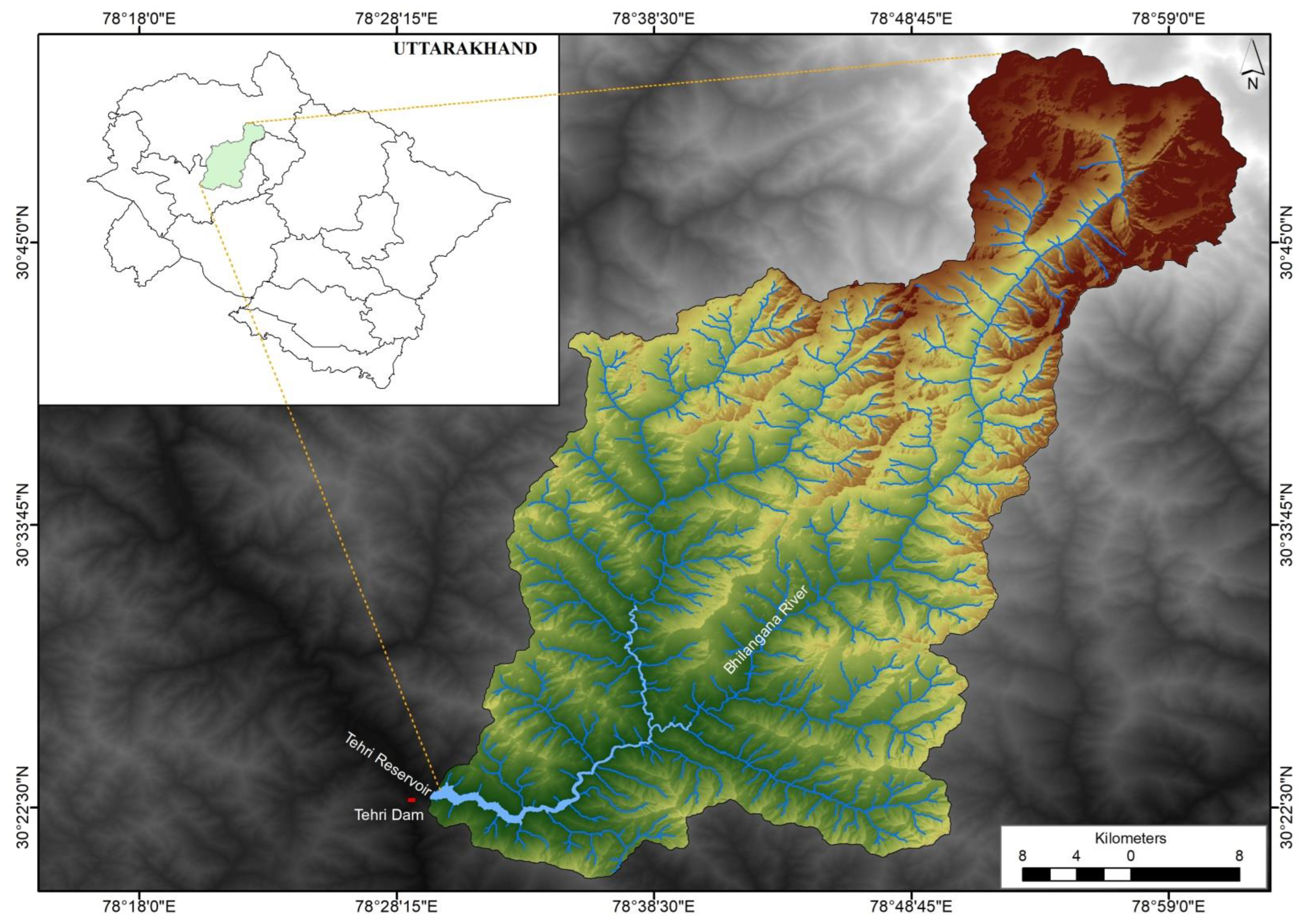
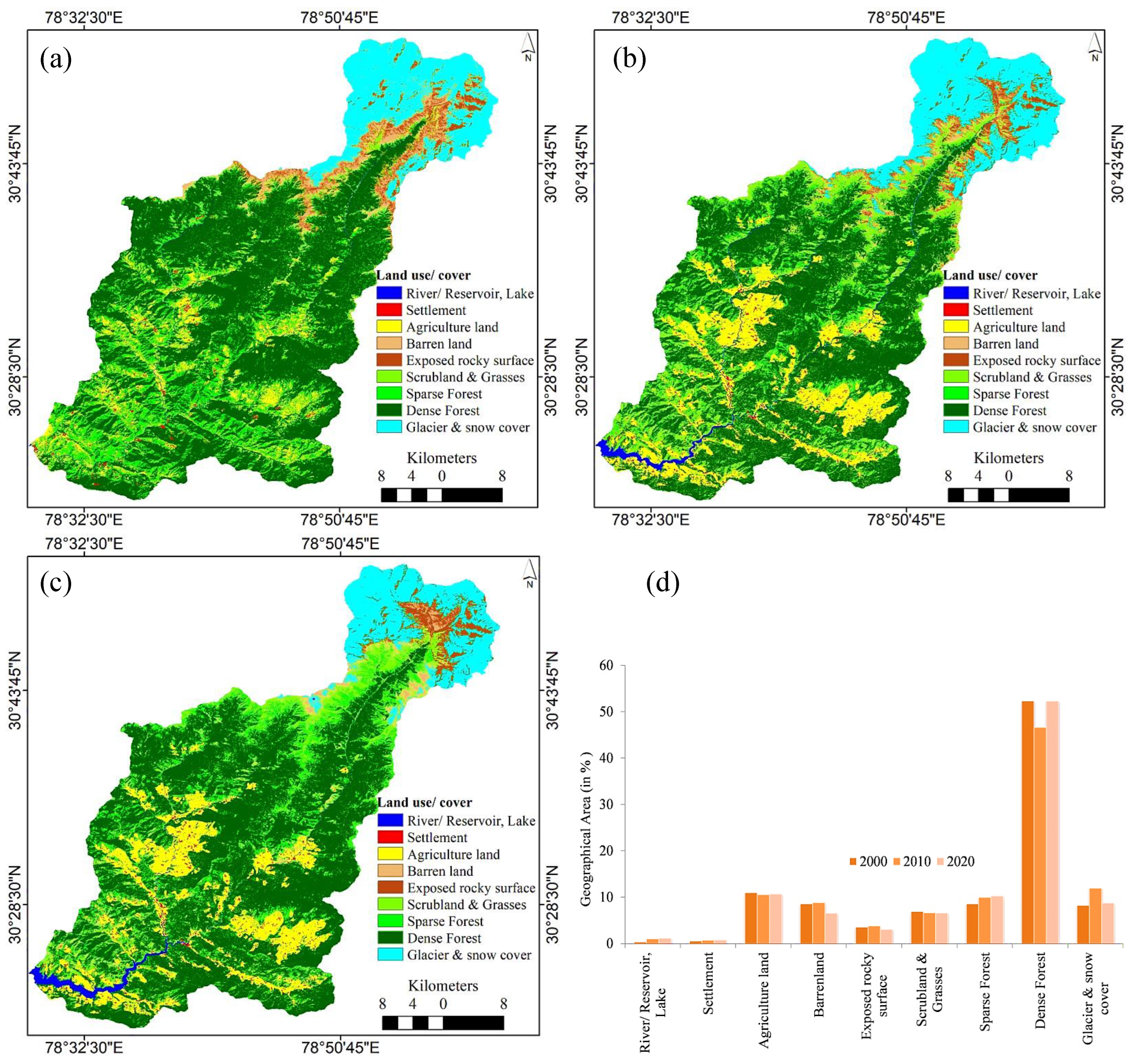
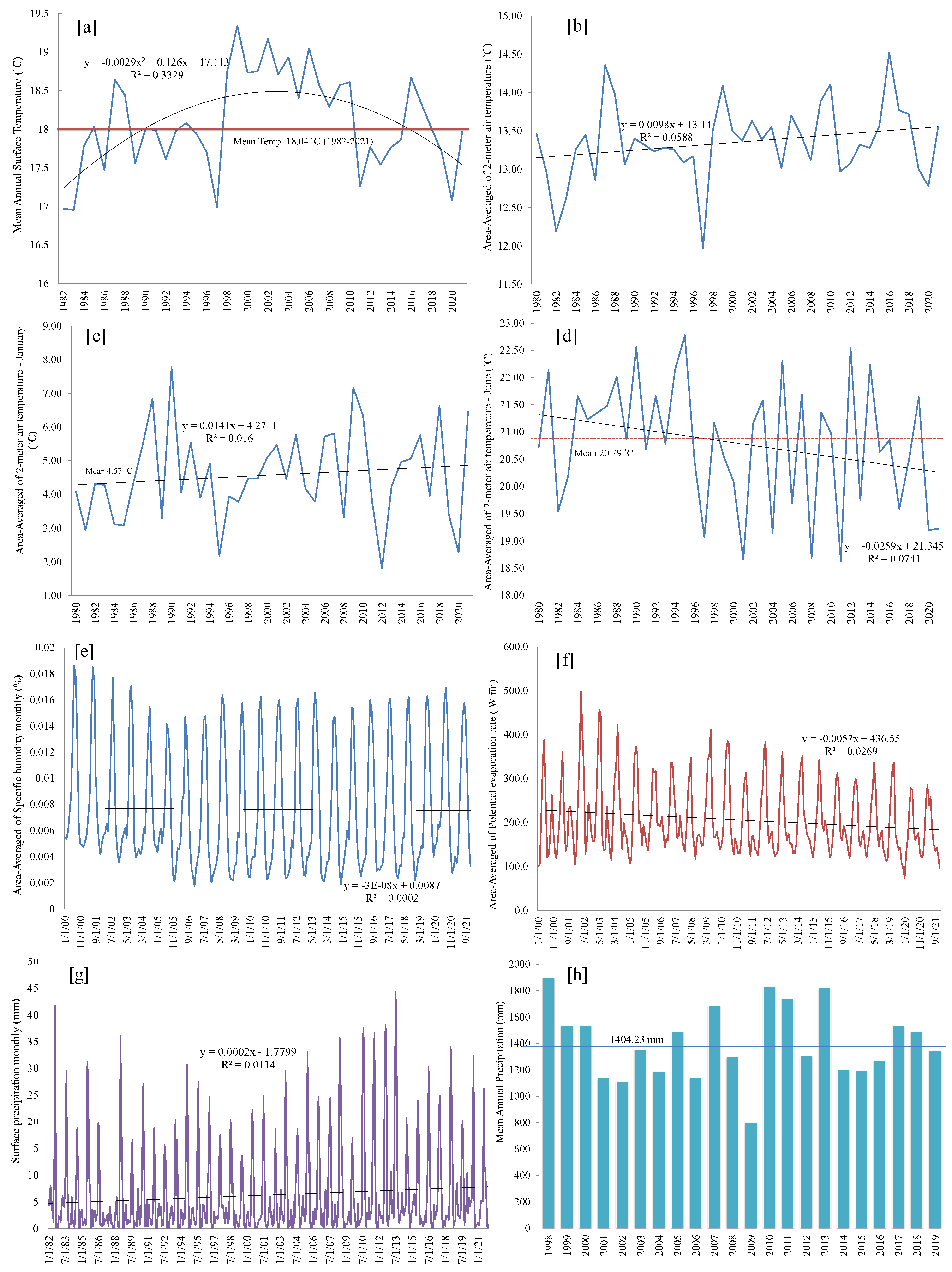

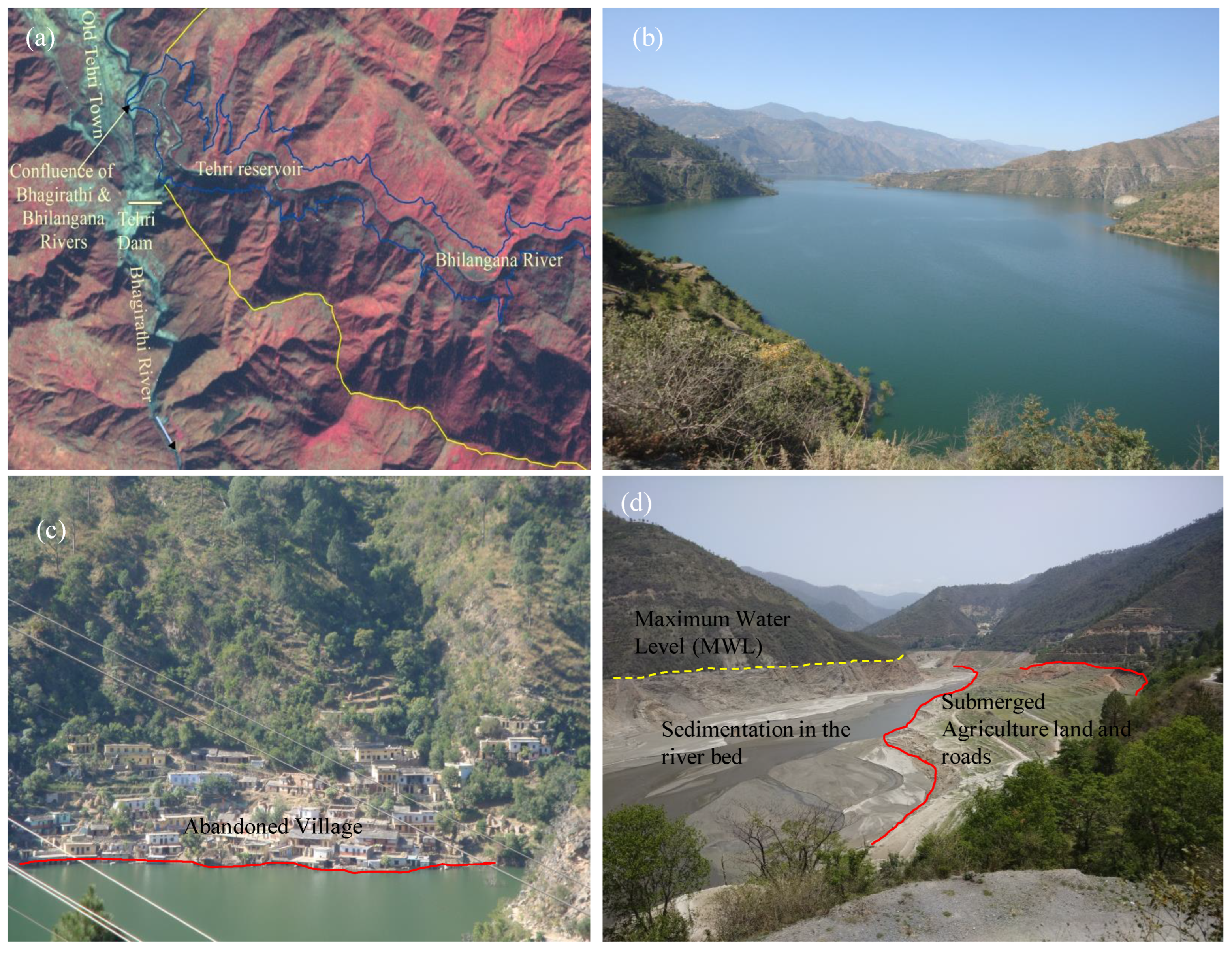
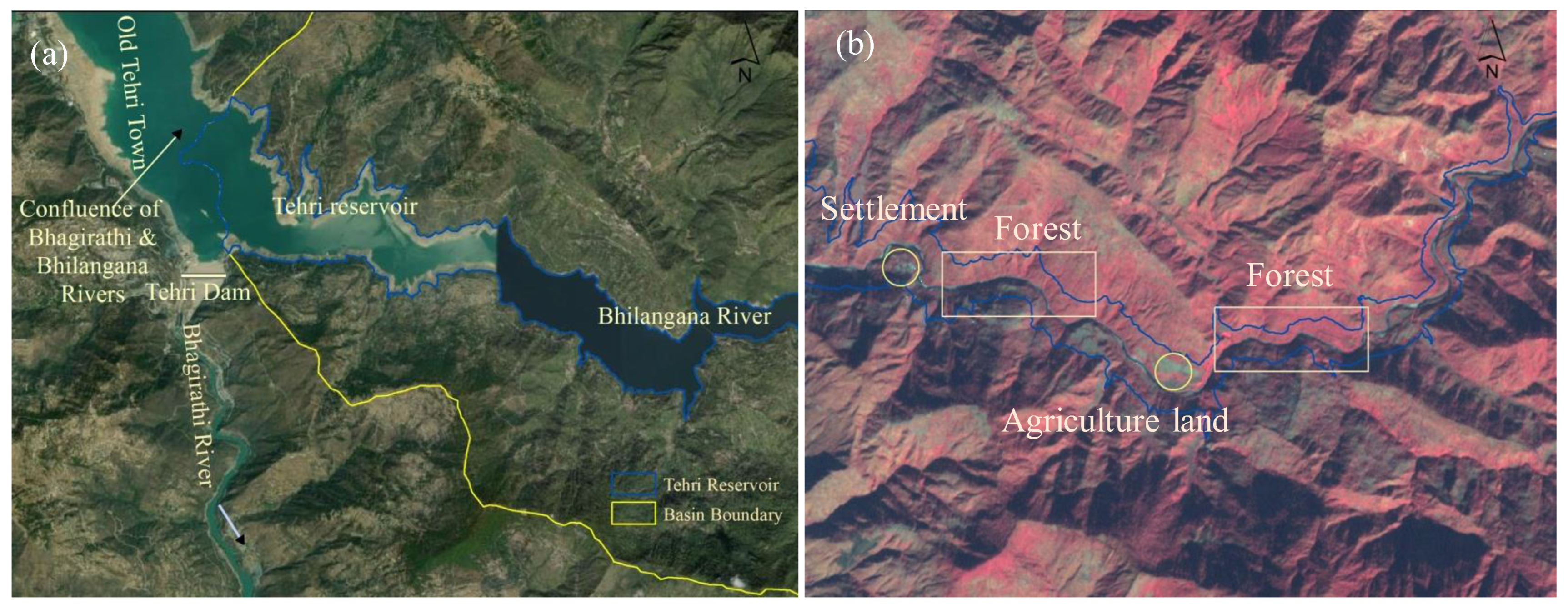
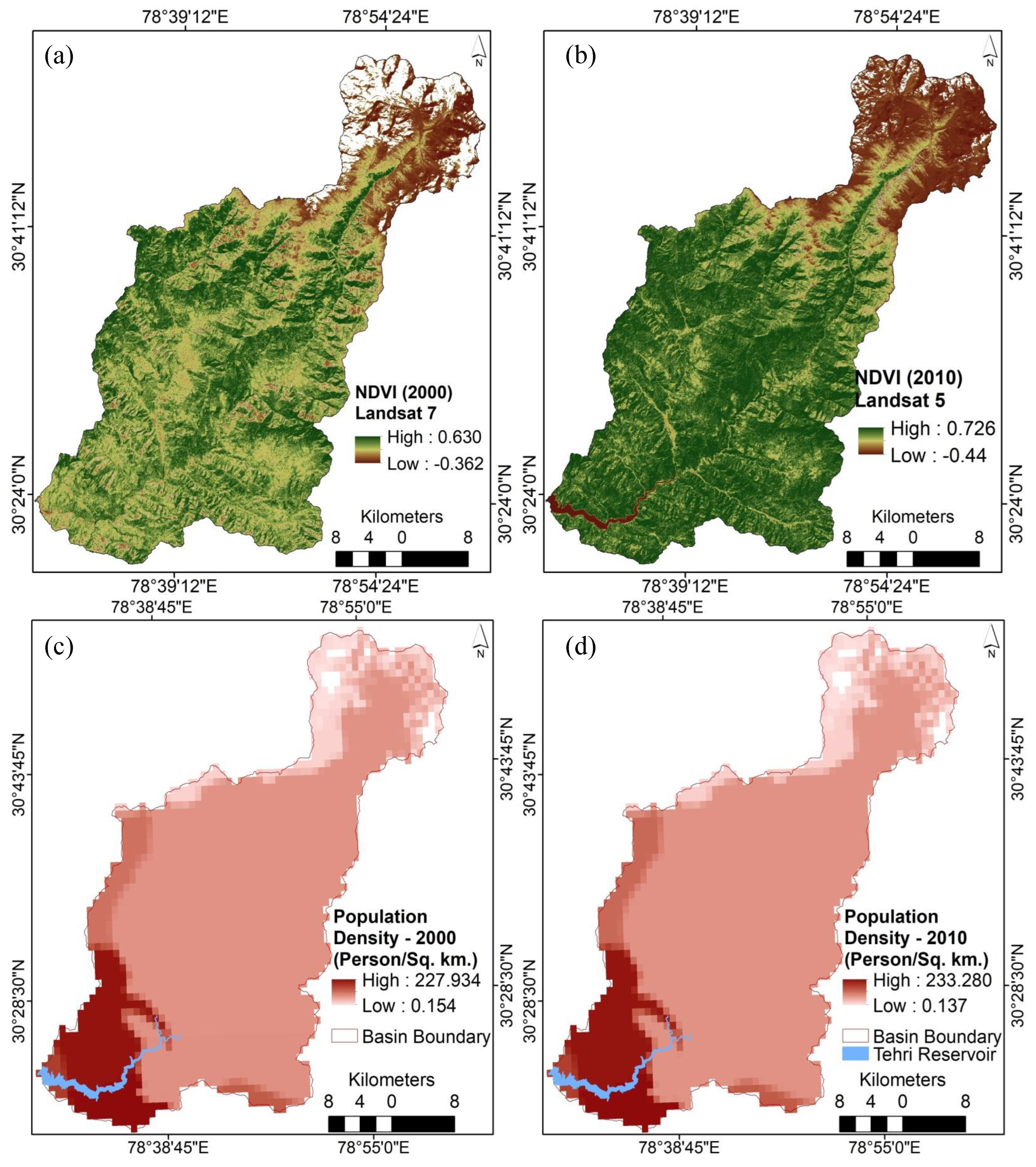
| Category | 2000 | 2010 | 2020 | |||
|---|---|---|---|---|---|---|
| Area (km²) | % of Area | Area (km²) | % of Area | Area (km²) | % of Area | |
| River/Reservoir, Lake | 4.86 | 0.33 | 15.36 | 1.03 | 16.86 | 1.14 |
| Settlement | 8.11 | 0.55 | 10.58 | 0.71 | 11.57 | 0.78 |
| Agriculture land | 162.58 | 10.95 | 156.52 | 10.55 | 158.46 | 10.67 |
| Barren land | 127.36 | 8.58 | 130.63 | 8.80 | 97.38 | 6.56 |
| Exposed rocky surface | 52.80 | 3.56 | 56.06 | 3.78 | 45.36 | 3.06 |
| Scrubland & Grasses | 102.78 | 6.92 | 98.55 | 6.64 | 97.59 | 6.57 |
| Sparse Forest | 127.32 | 8.58 | 147.61 | 9.95 | 152.23 | 10.25 |
| Dense Forest | 776.42 | 52.31 | 691.71 | 46.61 | 775.85 | 52.26 |
| Glacier & snow cover | 121.97 | 8.22 | 177.13 | 11.93 | 129.41 | 8.72 |
| Total | 1484.20 | 100.00 | 1484.16 | 100.00 | 1484.72 | 100.00 |
Publisher’s Note: MDPI stays neutral with regard to jurisdictional claims in published maps and institutional affiliations. |
© 2022 by the authors. Licensee MDPI, Basel, Switzerland. This article is an open access article distributed under the terms and conditions of the Creative Commons Attribution (CC BY) license (https://creativecommons.org/licenses/by/4.0/).
Share and Cite
Parihar, S.M.; Pandey, V.K.; Anshu; Shree, K.; Moin, K.; Ali, M.B.; Narasimhan, K.; Rai, J.; Kamil, A. Land Use Dynamics and Impact on Regional Climate Post-Tehri Dam in the Bhilangana Basin, Garhwal Himalaya. Sustainability 2022, 14, 10221. https://doi.org/10.3390/su141610221
Parihar SM, Pandey VK, Anshu, Shree K, Moin K, Ali MB, Narasimhan K, Rai J, Kamil A. Land Use Dynamics and Impact on Regional Climate Post-Tehri Dam in the Bhilangana Basin, Garhwal Himalaya. Sustainability. 2022; 14(16):10221. https://doi.org/10.3390/su141610221
Chicago/Turabian StyleParihar, Seema Mehra, Vijendra Kumar Pandey, Anshu, Karuna Shree, Khusro Moin, Mohammed Baber Ali, Kanchana Narasimhan, Jeetesh Rai, and Azka Kamil. 2022. "Land Use Dynamics and Impact on Regional Climate Post-Tehri Dam in the Bhilangana Basin, Garhwal Himalaya" Sustainability 14, no. 16: 10221. https://doi.org/10.3390/su141610221
APA StyleParihar, S. M., Pandey, V. K., Anshu, Shree, K., Moin, K., Ali, M. B., Narasimhan, K., Rai, J., & Kamil, A. (2022). Land Use Dynamics and Impact on Regional Climate Post-Tehri Dam in the Bhilangana Basin, Garhwal Himalaya. Sustainability, 14(16), 10221. https://doi.org/10.3390/su141610221






